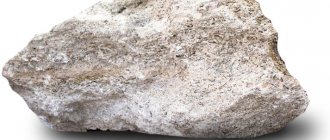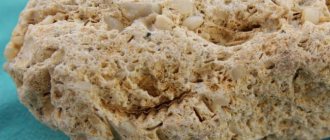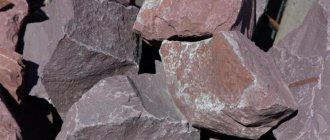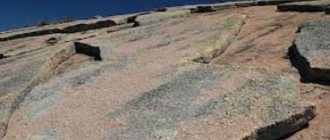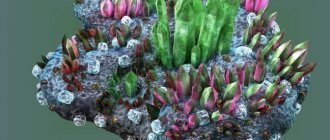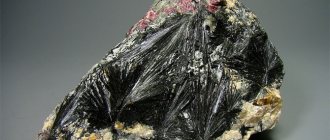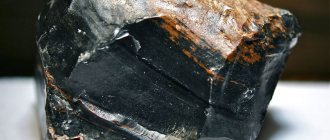Limestone as a mineral, properties of limestone:
Limestone is a sedimentary, clastic rock of organic, less often chemogenic origin, consisting mainly of calcium carbonate (CaCO3) in the form of calcite crystals of various sizes. The composition of limestone includes various impurities; in some cases, individual shells are distinguishable and recognizable in the limestone.
Limestone is a mineral formed in the seas and oceans, as well as in freshwater bodies. Limestone deposits were formed in different geological eras. The formation of most limestones occurred and is currently occurring (for example, coral reefs) due to the extraction of calcium carbonate by living organisms from sea water to build shells and skeletons. The remains of dead living organisms settle and accumulate on the seabed. Calcium carbonate, precipitated from the water saturated with it, is added to the settled limestone debris on the seabed.
Rice. 1. Limestone
Limestone is a natural stone, known and used in construction since ancient times. As a rock, limestone is used to a greater extent than other types of stone, with the exception of marble and granite.
Limestone has a different structure: from very small (on the order of several micrometers) grains to large (the size of a pea).
The color of limestone has a wide range of colors: white, gray, yellow, pink, peach, gray-lilac, brown, brown, blue, as well as all their possible combinations and shades. The color of limestone is determined by the presence or absence of impurities.
Limestone is a soft and porous material that can be easily processed.
Limestone deposits are found on almost all continents, with the exception of Australia. The thickness of the layers varies from several centimeters to hundreds of meters.
Rice. 2. Limestone
Pure limestone in its chemical composition consists of calcite. At the same time, 56% is formed by CaO and 44% by CO2.
contained in limestone can slowly dissolve in water and also decompose into carbon dioxide and corresponding bases.
The first process is the most important factor in the formation of karst, the second, occurring at great depths under the influence of the deep heat of the Earth, provides a source of gas for mineral waters.
Application of limestone
Limestone has universal applications in industry, agriculture and construction. In metallurgy, limestone serves as a flux. In the production of lime and cement, limestone is the main component. Limestone is used in the chemical and food industries: as an auxiliary material in the production of soda, calcium carbide, mineral fertilizers, glass, sugar, and paper.
It is used in the purification of petroleum products, dry distillation of coal, in the manufacture of paints, putties, rubber, plastics, soap, medicines, mineral wool, for cleaning fabrics and treating leather, and liming soils.
Limestone is the most important building material; it is used to make facing slabs, wall blocks, sculptural and architectural-building products, crushed stone for the production of concrete and asphalt concrete, railway ballast, road bases and surfaces, hydraulic filters, as rubble stone for foundations, paving slopes, sides and etc.
Slightly fractured soft limestone is often cut into blocks directly from the massif using various stone-cutting machines. Such limestones (saw limestones) are especially valuable as building materials.
Physico-mechanical properties of limestone:
| Indicator name | Meaning |
| Bulk density, tons/m3 | from 0.8 (for shell rocks and travertine) to 2.8 (for crystalline limestones) |
| Mohs hardness | 3 |
| Water absorption,% | 0.1 to 2.1 |
| Dry compressive strength, MPa | from 0.4 (for shell rocks) to 300 (for crystalline limestones) |
| Porosity, % | from 0.5 to 35 |
| Strength reduction coefficient when dense limestones are saturated with water | 0,65 – 0,85 |
| Strength reduction coefficient when soft limestones are saturated with water | 0,50 – 0,70 |
| Decomposition temperature, оС | 800 – 900 |
| Melting point, oC | 1242 |
| Frost resistance for crystalline limestones, cycles | 300 – 400 |
Limestone deposits in Russia
The Russian platform, as a former sea, is a key supplier of limestone in Russia. For example, white limestone suitable for cement is mined in the Moscow and Ryazan regions (Afanasyevskoye and Pronskoye deposits).
Flux stone is extracted in Russian regions:
- Tula (at the Barsukovskoye and Urusovskoye fields);
- Sverdlovskaya (Galyanskoe);
- Chelyabinsk (Sukhorechenskoye, Turgoyakskoye);
- Orenburgskaya (on Akkermanovsky);
- Leningradskaya (Pikalevskoye field);
- Tomsk region (Gurievsky).
Badrak-Alminskoye, Balaklaevskoye (Crimea) supplies excellent white shell rock.
Types and varieties of limestone:
There are many types and varieties of limestone : shell rock, chalk, oolitic limestone, pisolite limestone, travertine, tuff, dolomitized limestone, etc.
Shell rock is an accumulation of fragments of shells of marine animals and their fragments, cemented into a cellular aggregate.
If the shells of marine animals and their fragments are microscopic in size (about 5-10 microns), a loosely bound, soft, finely crumbling, smearing rock is formed - chalk . Chalk is up to 75% formed by organic remains - skeletal shells (shells) of planktonic algae-coccolithophores, as well as skeletal shells (shells) of microscopic foraminiferal mollusks.
Rice. 3. Limestone
Nummulite and fusuline limestone consists of the shells of ancient protozoa: the flattened round shells of nummulites and the elongated, spindle-shaped shells of fusulines.
Oolitic limestone consists of small, fish egg-sized balls cemented together. The core of each such oolite ball can be represented by a grain of sand, a fragment of a shell, or a particle of some other foreign material.
If the balls are larger, the size of a pea, they are called pisolites , and the rock is pisolite limestone .
Travertine is limestone formed on the surface as a result of the precipitation of calcium carbonate (calcite or aragonite) from the water of carbon dioxide sources.
If such deposits are highly porous (spongy), they are called calcareous tuff .
Marl is an uncemented mixture of calcium carbonate and clay.
Under the influence of metamorphic processes, limestone recrystallizes and forms marble. Transitional varieties of limestone are called marbled limestones .
Dolomitized limestone is a type of limestone containing up to 17% MgO. With a higher content of magnesium oxide impurities, the rock is called dolomite . The chemical formula of dolomite is CaMg(CO3)2.
There are other varieties of limestone.
Rice. 4. Limestone
Based on their origin, limestones are divided into:
– organogenic limestones – limestones formed due to the accumulation of organic residues (shell rocks, slurry and reef limestones);
– chemogenic limestones – limestones resulting from the precipitation of calcite from solutions;
– detrital limestones – limestones formed due to the accumulation of fragments – products of the destruction of older limestones.
Based on structural characteristics, limestones are divided into dense, porous, marble-like and earthy.
Dense limestones consist partly of extremely fine grains of lime spar (calcite), but mostly of fragments of calcareous shells and shells of various organisms. Typically dense limestones are yellowish, brown, and gray in color and are found in all geological formations, often as thick deposits.
Porous limestones - calcareous tuff, travertine, shell rocks and other rocks. They often contain plant remains, mollusk shells, and the like.
Marble-like or crystalline limestones - various types of marble, marbled limestones.
Earthy limestones – chalk.
Depending on the structure and nature of the grain size, limestones are divided into:
– oolitic limestones – limestones having a coarse-grained structure with calcite formations, round grains of a concentric shell-like structure, more or less densely cemented;
– pisolite limestones – limestones whose grains reach the size of a pea and consist of aragonite.
Rice. 5. Limestone
The nature and degree of grain size of limestones can vary significantly. Sometimes well-defined layering is observed in limestones.
Properties and uses of shell rock
Shell rock is used as a building material. This choice is due to the advantages of the mineral:
- abrasion resistant;
- heat resistant;
- combines well with other building materials;
- almost does not conduct heat;
- has noise absorption properties;
- easy to process;
- has bactericidal properties.
Disadvantages include light coloring, due to which the surface of the stone quickly becomes dirty without treatment with special solutions.
The stone must be transported carefully, because
If they fall, the shell rock slabs may break. For the same reason, you cannot build tall buildings from shell rock - they will easily collapse.
Stone is used both for building walls or pouring foundations, and for decoration. Limestone slabs cover walls, floors, fences, door and window openings. The stone is ideal for the construction of baths, saunas, and bathrooms. There will be no dampness or mold in rooms decorated with shell rock.
Crushed shellfish is used as a food additive for farm animals and birds. It increases bone strength and strengthens the shell of bird eggs. Animals become less susceptible to diseases.
Physicochemical characteristics
The texture of the stone is spongy and porous. The physical properties of the mineral ideally suit construction purposes:
- density 2.1 grams per cubic centimeter;
- thermal conductivity 0.3–0.8 W/m × K;
- water absorption – 15%;
- frost resistance - 25 cycles.
The mineral composition of shellfish includes calcium, sodium, iodine. The size of the shell slab is 180 × 380 × 380 mm, weight depending on the brand is 15–25 kg. Thanks to its porous structure, the mineral works as a filter, trapping harmful substances coming from outside.
Healing and magical properties
Shell rock has a beneficial effect on the body due to its salt and iodine content. In a room lined with shell shell, a healthy microclimate is maintained, the air is neutralized and saturated with substances beneficial to the immune system and the thyroid gland.
Its qualities are applicable only in construction. Neither jewelry nor amulets are made from shell rock. However, the pleasant color of the stone and its ability to purify the air have a beneficial effect on the nervous system, soothe and give a good mood.
